[English] 日本語
 Yorodumi
Yorodumi- PDB-7nrh: Hantaan virus glycoprotein (Gn) in complex with Fab fragment HTN-Gn1. -
+ Open data
Open data
- Basic information
Basic information
| Entry | Database: PDB / ID: 7nrh | ||||||
|---|---|---|---|---|---|---|---|
| Title | Hantaan virus glycoprotein (Gn) in complex with Fab fragment HTN-Gn1. | ||||||
 Components Components |
| ||||||
 Keywords Keywords |  VIRUS LIKE PARTICLE / VLP / VIRUS LIKE PARTICLE / VLP /  virus-like particle / Hantaan / HTNV / HNTV / virus-like particle / Hantaan / HTNV / HNTV /  glycoprotein / spike / glycoprotein / spike /  fab / HTN-Gn1 / fab / HTN-Gn1 /  antibody / antibody /  epitope epitope | ||||||
| Function / homology |  Function and homology information Function and homology information: / symbiont-mediated suppression of host TRAF-mediated signal transduction / host cell Golgi membrane / host cell mitochondrion / host cell surface / host cell endoplasmic reticulum membrane / virion membrane /  signal transduction / signal transduction /  membrane / membrane /  metal ion binding metal ion bindingSimilarity search - Function | ||||||
| Biological species |   Oryctolagus cuniculus (rabbit) Oryctolagus cuniculus (rabbit) Hantaan orthohantavirus Hantaan orthohantavirus | ||||||
| Method |  ELECTRON MICROSCOPY / subtomogram averaging / ELECTRON MICROSCOPY / subtomogram averaging /  cryo EM / Resolution: 19 Å cryo EM / Resolution: 19 Å | ||||||
 Authors Authors | Stass, R. / Rissanen, I. / Bowden, T.A. / Huiskonen, J.T. | ||||||
| Funding support |  United Kingdom, 1items United Kingdom, 1items
| ||||||
 Citation Citation |  Journal: mBio / Year: 2021 Journal: mBio / Year: 2021Title: Structural Basis for a Neutralizing Antibody Response Elicited by a Recombinant Hantaan Virus Gn Immunogen. Authors: Ilona Rissanen / Stefanie A Krumm / Robert Stass / Annalis Whitaker / James E Voss / Emily A Bruce / Sylvia Rothenberger / Stefan Kunz / Dennis R Burton / Juha T Huiskonen / Jason W Botten / ...Authors: Ilona Rissanen / Stefanie A Krumm / Robert Stass / Annalis Whitaker / James E Voss / Emily A Bruce / Sylvia Rothenberger / Stefan Kunz / Dennis R Burton / Juha T Huiskonen / Jason W Botten / Thomas A Bowden / Katie J Doores /     Abstract: Hantaviruses are a group of emerging pathogens capable of causing severe disease upon zoonotic transmission to humans. The mature hantavirus surface presents higher-order tetrameric assemblies of two ...Hantaviruses are a group of emerging pathogens capable of causing severe disease upon zoonotic transmission to humans. The mature hantavirus surface presents higher-order tetrameric assemblies of two glycoproteins, Gn and Gc, which are responsible for negotiating host cell entry and constitute key therapeutic targets. Here, we demonstrate that recombinantly derived Gn from Hantaan virus (HTNV) elicits a neutralizing antibody response (serum dilution that inhibits 50% infection [ID], 1:200 to 1:850) in an animal model. Using antigen-specific B cell sorting, we isolated monoclonal antibodies (mAbs) exhibiting neutralizing and non-neutralizing activity, termed mAb HTN-Gn1 and mAb nnHTN-Gn2, respectively. Crystallographic analysis reveals that these mAbs target spatially distinct epitopes at disparate sites of the N-terminal region of the HTNV Gn ectodomain. Epitope mapping onto a model of the higher order (Gn-Gc) spike supports the immune accessibility of the mAb HTN-Gn1 epitope, a hypothesis confirmed by electron cryo-tomography of the antibody with virus-like particles. These data define natively exposed regions of the hantaviral Gn that can be targeted in immunogen design. The spillover of pathogenic hantaviruses from rodent reservoirs into the human population poses a continued threat to human health. Here, we show that a recombinant form of the Hantaan virus (HTNV) surface-displayed glycoprotein, Gn, elicits a neutralizing antibody response in rabbits. We isolated a neutralizing (HTN-Gn1) and a non-neutralizing (nnHTN-Gn2) monoclonal antibody and provide the first molecular-level insights into how the Gn glycoprotein may be targeted by the antibody-mediated immune response. These findings may guide rational vaccine design approaches focused on targeting the hantavirus glycoprotein envelope. | ||||||
| History |
|
- Structure visualization
Structure visualization
| Movie |
 Movie viewer Movie viewer |
|---|---|
| Structure viewer | Molecule:  Molmil Molmil Jmol/JSmol Jmol/JSmol |
- Downloads & links
Downloads & links
- Download
Download
| PDBx/mmCIF format |  7nrh.cif.gz 7nrh.cif.gz | 312.5 KB | Display |  PDBx/mmCIF format PDBx/mmCIF format |
|---|---|---|---|---|
| PDB format |  pdb7nrh.ent.gz pdb7nrh.ent.gz | 264.3 KB | Display |  PDB format PDB format |
| PDBx/mmJSON format |  7nrh.json.gz 7nrh.json.gz | Tree view |  PDBx/mmJSON format PDBx/mmJSON format | |
| Others |  Other downloads Other downloads |
-Validation report
| Arichive directory |  https://data.pdbj.org/pub/pdb/validation_reports/nr/7nrh https://data.pdbj.org/pub/pdb/validation_reports/nr/7nrh ftp://data.pdbj.org/pub/pdb/validation_reports/nr/7nrh ftp://data.pdbj.org/pub/pdb/validation_reports/nr/7nrh | HTTPS FTP |
|---|
-Related structure data
| Related structure data |  12544MC  7nksC 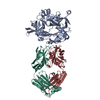 7o9sC M: map data used to model this data C: citing same article ( |
|---|---|
| Similar structure data |
- Links
Links
- Assembly
Assembly
| Deposited unit | 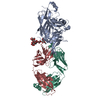
|
|---|---|
| 1 |
|
- Components
Components
| #1: Antibody | Mass: 24284.264 Da / Num. of mol.: 1 Source method: isolated from a genetically manipulated source Source: (gene. exp.)   Oryctolagus cuniculus (rabbit) / Production host: Oryctolagus cuniculus (rabbit) / Production host:   Homo sapiens (human) Homo sapiens (human) |
|---|---|
| #2: Antibody | Mass: 22943.162 Da / Num. of mol.: 1 Source method: isolated from a genetically manipulated source Source: (gene. exp.)   Oryctolagus cuniculus (rabbit) / Production host: Oryctolagus cuniculus (rabbit) / Production host:   Homo sapiens (human) Homo sapiens (human) |
| #3: Protein | Mass: 40350.871 Da / Num. of mol.: 1 Source method: isolated from a genetically manipulated source Source: (gene. exp.)  Hantaan orthohantavirus / Production host: Hantaan orthohantavirus / Production host:   Homo sapiens (human) / References: UniProt: A0A077D153 Homo sapiens (human) / References: UniProt: A0A077D153 |
| #4: Polysaccharide | alpha-D-mannopyranose-(1-2)-alpha-D-mannopyranose-(1-3)-[alpha-D-mannopyranose-(1-3)-alpha-D- ...alpha-D-mannopyranose-(1-2)-alpha-D-mannopyranose-(1-3)-[alpha-D-mannopyranose-(1-3)-alpha-D-mannopyranose-(1-6)]beta-D-mannopyranose-(1-4)-2-acetamido-2-deoxy-beta-D-glucopyranose-(1-4)-2-acetamido-2-deoxy-beta-D-glucopyranose / Mass: 1235.105 Da / Num. of mol.: 1 / Mass: 1235.105 Da / Num. of mol.: 1Source method: isolated from a genetically manipulated source |
| Has ligand of interest | N |
-Experimental details
-Experiment
| Experiment | Method:  ELECTRON MICROSCOPY ELECTRON MICROSCOPY |
|---|---|
| EM experiment | Aggregation state: PARTICLE / 3D reconstruction method: subtomogram averaging |
- Sample preparation
Sample preparation
| Component | Name: Hantaan orthohantavirus / Type: VIRUS / Entity ID: #1-#3 / Source: RECOMBINANT / Type: VIRUS / Entity ID: #1-#3 / Source: RECOMBINANT |
|---|---|
| Source (natural) | Organism:  Hantaan orthohantavirus Hantaan orthohantavirus |
| Source (recombinant) | Organism:   Homo sapiens (human) Homo sapiens (human) |
| Details of virus | Empty: YES / Enveloped: YES / Isolate: SPECIES / Type: VIRUS-LIKE PARTICLE |
| Buffer solution | pH: 7.5 / Details: PBS |
| Specimen | Embedding applied: NO / Shadowing applied: NO / Staining applied : NO / Vitrification applied : NO / Vitrification applied : YES : YES |
Vitrification | Cryogen name: ETHANE-PROPANE |
- Electron microscopy imaging
Electron microscopy imaging
| Experimental equipment |  Model: Titan Krios / Image courtesy: FEI Company |
|---|---|
| Microscopy | Model: FEI TITAN KRIOS |
| Electron gun | Electron source : :  FIELD EMISSION GUN / Accelerating voltage: 300 kV / Illumination mode: FLOOD BEAM FIELD EMISSION GUN / Accelerating voltage: 300 kV / Illumination mode: FLOOD BEAM |
| Electron lens | Mode: BRIGHT FIELD Bright-field microscopy Bright-field microscopy |
| Image recording | Electron dose: 4.77 e/Å2 / Film or detector model: GATAN K2 SUMMIT (4k x 4k) |
- Processing
Processing
| EM software | Name: Dynamo / Category: 3D reconstruction |
|---|---|
CTF correction | Type: PHASE FLIPPING ONLY |
| Symmetry | Point symmetry : C1 (asymmetric) : C1 (asymmetric) |
3D reconstruction | Resolution: 19 Å / Resolution method: FSC 0.143 CUT-OFF / Num. of particles: 2380 / Symmetry type: POINT |
| EM volume selection | Num. of tomograms: 42 / Num. of volumes extracted: 34460 |
 Movie
Movie Controller
Controller




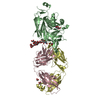
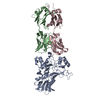
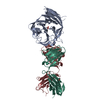

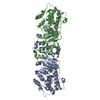
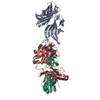
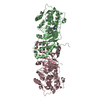

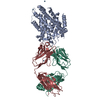
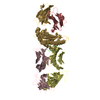
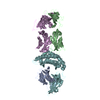
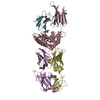
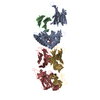

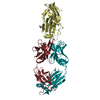
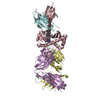
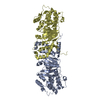
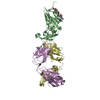

 PDBj
PDBj

